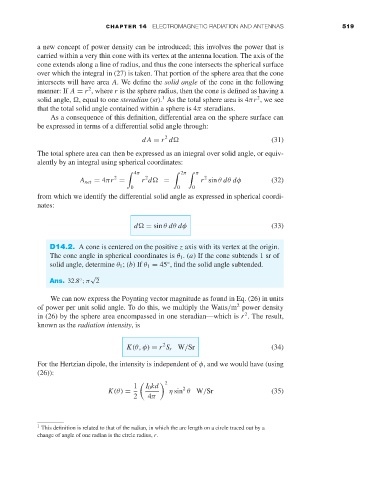Page 537 - Engineering Electromagnetics, 8th Edition
P. 537
CHAPTER 14 ELECTROMAGNETIC RADIATION AND ANTENNAS 519
anew concept of power density can be introduced; this involves the power that is
carried within a very thin cone with its vertex at the antenna location. The axis of the
cone extends along a line of radius, and thus the cone intersects the spherical surface
over which the integral in (27) is taken. That portion of the sphere area that the cone
intersects will have area A.We define the solid angle of the cone in the following
2
manner: If A = r , where r is the sphere radius, then the cone is defined as having a
2
1
solid angle,
, equal to one steradian (sr). As the total sphere area is 4πr ,wesee
that the total solid angle contained within a sphere is 4π steradians.
As a consequence of this definition, differential area on the sphere surface can
be expressed in terms of a differential solid angle through:
2
dA = r d
(31)
The total sphere area can then be expressed as an integral over solid angle, or equiv-
alently by an integral using spherical coordinates:
4π 2π π
2 2 2
A net = 4πr = r d
= r sin θ dθ dφ (32)
0 0 0
from which we identify the differential solid angle as expressed in spherical coordi-
nates:
d
= sin θ dθ dφ (33)
D14.2. A cone is centered on the positive z axis with its vertex at the origin.
The cone angle in spherical coordinates is θ 1 .(a)If the cone subtends 1 sr of
solid angle, determine θ 1 ;(b)If θ 1 = 45 , find the solid angle subtended.
◦
√
Ans. 32.8 ; π 2
◦
We can now express the Poynting vector magnitude as found in Eq. (26) in units
2
of power per unit solid angle. To do this, we multiply the Watts/m power density
2
in (26) by the sphere area encompassed in one steradian—which is r . The result,
known as the radiation intensity,is
2
K(θ, φ) = r S r W/Sr (34)
For the Hertzian dipole, the intensity is independent of φ, and we would have (using
(26)):
1 I 0 kd 2
2
K(θ) = η sin θ W/Sr (35)
2 4π
1 This definition is related to that of the radian, in which the arc length on a circle traced out by a
change of angle of one radian is the circle radius, r.

